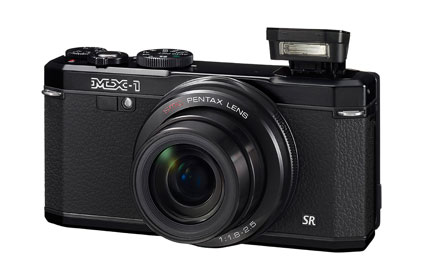
This retro-looking prosumer compact camera took the Red Dot Design Winner Award this year. Its design is inspired by the Pentax MX, an SLR that used 35mm film and was produced in the 1970s.
The MX-1 looks really cool. It has top and bottom brass plates and leather wrapped around the middle of its body. While it feels solid and sturdy, it lacks useful ergonomic contours and denies you a firm grip.
It is also very thick - think seven Apple iPhone 5s. This makes it impossible to slip it into your pocket.
Another inexplicable quirk is its front strap lugs, which causes the camera to tilt backwards when slung on your arm.
It does not have a built-in electronic viewfinder or a hot shoe to mount an external one. But it does have a tiltable display that you can flip up by 45 degrees and down by 90 degrees.
Button layout is good but could have been better. While your thumb can easily reach the rear dial and exposure compensation dial, the top mode dial - which sits to the left of the shutter release - requires you to stretch your thumb a bit.
My biggest gripe, though, is the lack of an additional dial for quick changes of aperture or shutter speed in Manual mode. Pentax could have easily added a control ring around the lens barrel for this purpose.
Powering up the MX-1 takes a speedy 1.5 seconds; shutdown, 2.2sec. The 0.2sec shutter lag is negligible.

The MX-1's autofocusing (AF) is almost instantaneous in bright light. In very dark conditions, it also performs admirably. It locks focus as quick as 1.5sec, but may sometimes take as long as 2.5sec.
The lens can change automatically to macro mode when the lens is up close to an object. I found that it could focus on objects as close as 1cm from the lens.
Using an SD card with a writing speed of 25MB per second, the MX-1 is able to fire 10 JPEG Fine images in 2.16sec before the buffer runs out.
Image quality is very good, with nice tones, good dynamic range, vivid colours and impressive details. Auto white balance is spot on in most lighting conditions.
ISO performance is not as stellar. Noise artefacts creep in at ISO 800, but this is not significant. The image quality is still acceptable at ISO 1,600, but I do not recommend anything above that.
I found that the MX-1's metering system tends to overexpose the photo. I recommend setting an exposure compensation of minus 1/3 of a stop when using semi-auto modes, such as Aperture Priority.
The full high-definition video is equally good, but suffers from a wee bit of wind and ambient audio even with wind suppression activated. While the lens' AF is almost silent during video recording, the zooming of the lens can wake up a neighbourhood.
The battery life is pretty average, at around 300 frames on a full charge.
Overall, the Pentax MX-1 is a cool-looking camera with impressive image quality, as long as you can overlook the lack of a hot shoe and control ring.
Tech specs
Price: $799
Image sensor: 12-megapixel 1/1.7-inch
Display: 3-inch tiltable LCD with 920,000 dots
Lens: 28-112mm f/1.8 - f/2.5
Sensitivity: ISO 100 to 12,800
Shooting speed: Up to 4.2 frames per second
Weight: 391g (with battery and memory card)
Rating
Features: 3
Design: 3
Performance: 4
Value for money: 3
Battery life: 3
Overall: 3

